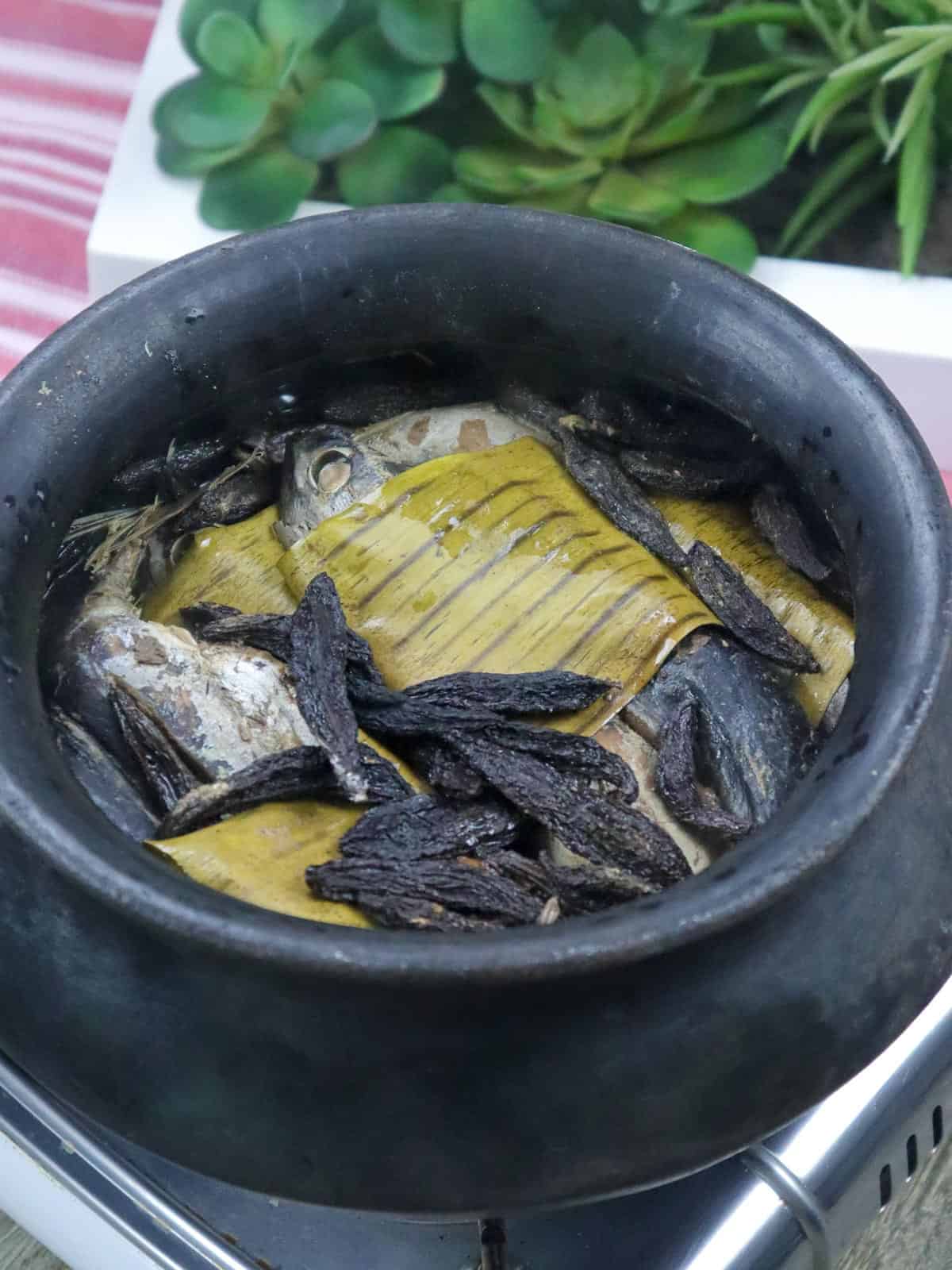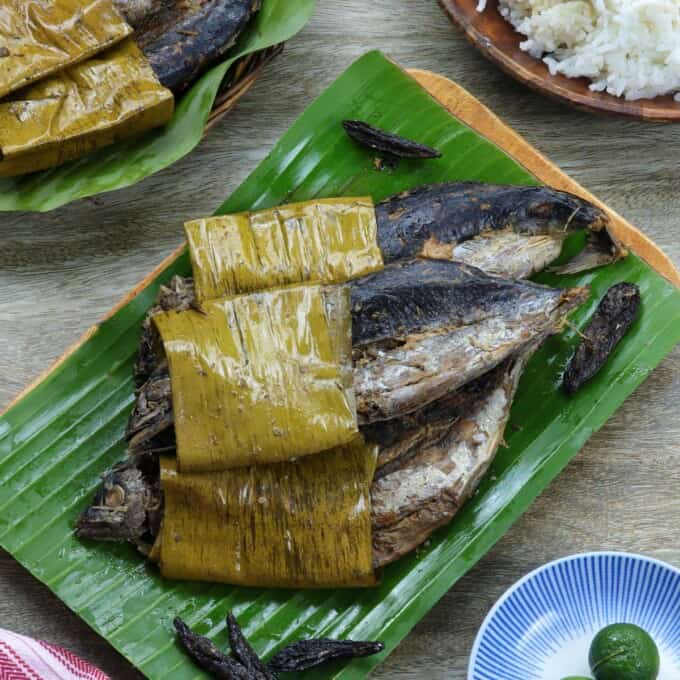Sinaing na Tulingan takes a good few hours to make, but it is so worth the effort. This popular delicacy is cooked low and slow in a clay pot until tender and flavorful, perfect with piping-hot steamed rice. It's comfort food at its best!

Batangas is the second-largest international seaport in the Philippines and is known for its rich coasts. Tawilis, a freshwater sardine, and tulingan or bullet tuna are just some of the fish abundant in the area.
Many of the province's famous delicacies make use of plentiful marine harvests such as sinigang na maliputo, tortang dulong, and of course, sinaing na tulingan.

What is sinaing
Sinaing refers to the steaming or boiling of food. The process involves cooking over a low fire using wood chunks or charcoal for 6-8 hours or overnight in some instances until the fish flesh and bones are soft to the bite.
Sinaing na Tulingan is a variant of this cooking method. The tuna is simmered in a clay pot or palayok low and slow until the flesh and bones are tender and infused with subtle tangy flavors.
It's traditionally prepared using tulingan, water, and salt. Vinegar and kamias are usually added to improve the taste.

This sinaing recipe is relatively easy to prepare albeit takes a good amount of time to cook. It's simple and economical with only five ingredients!
What you'll need
- Tulingan or Bullet Tuna- is a saltwater fish with a bluish back turning to deep purple on the head. If it's not readily available, meaty fish mackarel, galunggong (round scad), or bonito which come from the same family are also good options.
- Dried kamias or kalamyas- fresh ones work well too! If you don't have access to kamias or also known as bilimbi, other souring agents such as vinegar, tamarind, or calamansi can be used as an alternative.
- Pork belly or pork fat- layered on the bottom of the pot to prevent the fish from drying out as it cooks for a long time. The rendered oil from the pork enhances the dish and brings out the fish's natural flavors.
- Sukang Irok- also known as kaong palm vinegar or sukang kaong, is a traditional Filipino vinegar made from the sap of the sugar palm tree. It tends to be sweeter and is the least sour among traditional Filipino vinegar, lending the sinaing a subtle hint of sourness
- Salt- serves as a seasoning and preservative

How to prepare the fish
- Clean the fish thoroughly by removing the gills and innards. Using a knife, make an incision in the center of the fish.
- Soak in a bowl of cold water for about 20 to 30 minutes to remove the blood. Rinse a few times until the water runs mostly clear.
- Flatten the fish by pressing down with the palm of your hands.
- Generously season with rock salt.
- Wrap the upper part of the fish with a 2-inch strip of banana leaves to hold the fish together through the long period of cooking.
A poisonous tail or a wife's tale
Some believe that the tulingan’s tail is poisonous, which is the reason many remove it before cooking. However, this is all but a myth.
Certain kinds of fish like tuna, marlin, mackerel, and herring have naturally high levels of histidine, which turns to histamine or scombroid when the fish is stored improperly. Histamine toxicity can cause dizziness or an allergic reaction in some people.
The most common cause of scombrotoxic poisoning is eating spoiled fish. Inadequate refrigeration causes an overgrowth of bacteria which converts the histidine to high levels of histamine. For food safety, purchase your fish from a reputable source and store the fish at the proper temperatures.

Cooking tips
- If you wish to remove the fish's tail, twist at a 360-degree angle and pull it off gently. You would know if you did it correctly when a portion of the meat is attached to the tail.
- Although a claypot or palayok is traditional and yields the best flavor and aroma, a deep, thick-bottomed pot will work in a cinch.
- Use this recipe as a base and feel free to experiment with different spices and seasonings such as garlic, onion, ginger, chili peppers, soy sauce, pepper, and fish sauce.

How to serve
- Sinaing na Tulingan is delicious for breakfast, lunch, or dinner. Serve with slices of ripe tomatoes, onions, green mangoes, and steamed rice for the ultimate comfort food!
- Serve it with the remaining liquid, popularly termed “patis” for dipping sauce or drizzle over rice.
- A popular practice is to fry the leftovers or cook them in coconut milk for variety.
How to store
- The use of vinegar and salt prolongs shelf life. When stored properly, sinaing na isda will last for days. Transfer to an airtight container and refrigerate.
- Keep the remaining liquid from cooking to add back moisture when reheating.
Ingredients
- 2 ½ pounds (about 7 to 8 pieces) tulingan (bullet tuna)
- rock salt
- ½ pound pork belly
- 1 cup dried kamias (kalamyas or bilimbi)
- ½ cup sukang irok (kaong palm vinegar)
- water
Equipment
- Clay pot or palayok
Instructions
- Wipe banana leaves with a damp cloth to remove any dirt. Cut into about 2-inch thick strips and set aside.
- Clean the fish by removing the gills and innards. Make a slit in the center on both sides of the fish.
- Soak in a bowl of water for about 20 to 30 minutes to remove any blood. Rinse and drain well.
- Press the fish firmly with the palm of your hands to flatten.
- Generously rub fish with ½ cup rock salt. Wrap part of the body and head with banana leaf.
- In a clay pot, layer the bottom with banana leaves. Add pork belly and ½ cup dried kamias.
- Arrange fish in the pot, alternating positions.
- Add 1 tablespoon rock salt, ½ cup dried kamias, and sukang irok.
- Add enough water to cover fish. Cover with banana leaves.
- Cover with the palayok lid and bring to a boil.
- Lower heat and cook on low heat for about 4 to 5 hours or until flesh and bones are very tender, adding water in ½ cup increments if the liquid is drying out.
Notes
Video

Nutrition Information
“This website provides approximate nutrition information for convenience and as a courtesy only. Nutrition data is gathered primarily from the USDA Food Composition Database, whenever available, or otherwise other online calculators.”





Gigi Hinojales says
All menu I’ll try love love it and i want to try more
Lito says
Can you make it without banana leaves?
michael g. mallare says
talaga pong 4-5 hoursna cooking?
Lalaine Manalo says
Opo 🙂
Donna says
Hello po
I want to try this. Can i cook this on the slow cooker?